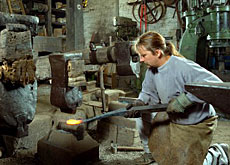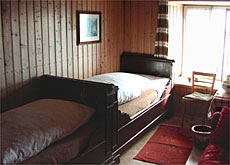No roads lead to mountain hotel

For more than 170 years, the Faulhorn Hotel has withstood countless strikes by lightning and everything else Mother Nature has been able to throw at it.
But the continued existence of the oldest surviving mountain hotel in the Alps is no longer certain.
Even though it has survived in its near original state, it is not a listed heritage building, which would guarantee its protection, because its owners cannot afford the high restoration costs.
“We’d have to invest a lot in the hotel, but we simply don’t have the money,” says Ursula Garbani of the Garbani-Mangott family, which has owned the hotel since 1930.
“It’s in need of renovation, that’s obvious [but] if you think how costly it is to transport the building materials alone [by helicopter], it’s a problem. It costs a lot more than it would for a building here in the valley,” Garbani says.
Built in 1830
The Faulhorn Hotel is situated at an altitude of 2,700 metres above sea level near the resort of Grindelwald.
Its construction, in 1830, was only the second time anyone in Europe had dared put a hotel on top of a mountain.
“Not only the building but the surroundings have also been preserved as they once were,” says Jürg Schweizer, head of the Office for Monument Protection in canton Bern.
“The hotel cannot be accessed by railway or cable car. One has to walk up on foot, as was the case 200 years ago, which means one sees the building and surrounding landscape in a completely different light. That’s exceptionally rare.”
Schweizer’s office has entered negotiations with the Garbani-Mangott family and he says the canton would be glad to put the hotel on its list of heritage buildings – an honour it has long deserved – and to cover about 30 per cent of the restoration costs.
Canton powerless
However, he says the canton is almost powerless if the owners do not take the first step and adds that the negotiations could go on for years.
Until the owners make a move, the hotel will continue to decay.
Garbani says her family has been investing in the upkeep of the Faulhorn but the bits of restoration and repair work already completed have been carried out without expert advice.
The façade for instance has been touched up with cement rather than lime plaster.
Rotting away
Not only is this not in keeping with the original building materials, but as Schweizer says, the cement coating acts like an air-tight seal, actually causing more damage in the long run by trapping moisture on the inside and promoting rot.
Making matters worse, the couple that have run the hotel for the past three years have torn up their lease and are leaving at the end of this year.
Christine Jucker and Hermann Inäbnit took over the hotel in 2000 hoping they could help the owners to give it back some of its 19th century gloss.
While they have dusted off a lot of antiques and put them back in their original places, they say they have not been able to earn a living.
They complain that the Garbani-Mangott family has not been willing to make the investments necessary to cut down on the high operating costs.
Fire hazard
Inäbnit also points out that the kitchen is a fire hazard. There are no safety valves on the gas stoves, which sit dangerously close to a wood-fired water boiler.
The Garbani-Mangott family admit finding a suitable replacement for Jucker and Inäbnit will not be easy and if none is found, they may have no choice but to close the hotel.
The family has also ruled out selling the building to someone who may have the means to restore it.
Family blood
That would be unthinkable, according to Ursula Garbani, who says the hotel is in her family’s blood. Her grandparents purchased the hotel in 1930, and her parents ran it until 1996. She would now like to see her youngest son take it over.
“He doesn’t yet know what he wants to do with his future. He’s interested in the hotel, but he’s simply too young at the moment,” she says. “That’s why we don’t want to sell it.”
Schweizer from the Office for Monument Protection says the hotel’s demise is not a foregone conclusion.
“There are a lot of [historical] buildings in the canton which are not listed but that doesn’t mean they aren’t protected,” he stresses.
“The cantonal building regulations and monument protection laws state clearly that historical buildings are to be considered monuments and are to be conserved.”
swissinfo/Dale Bechtel
Built in 1830, it is the oldest surviving mountain hotel in the Alps.
Despite its historic importance, it is not a listed heritage building.
The owners are considering closing the hotel next year.
The Faulhorn Hotel was built in 1830 on the mountain of the same name which is 2,700 metres above sea level. Tourists made the long steep hike up from Grindelwald to enjoy the views of the high peaks of the Bernese Oberland.
The hotel is not a listed heritage building, and is badly in need of restoration, particularly its outer walls and windows.
The office in canton Bern responsible for monument protection has held talks with the owners, but the owners say they do not have enough money to restore it properly.
The owners have not ruled out closing the hotel next year.

In compliance with the JTI standards
More: SWI swissinfo.ch certified by the Journalism Trust Initiative




You can find an overview of ongoing debates with our journalists here. Please join us!
If you want to start a conversation about a topic raised in this article or want to report factual errors, email us at english@swissinfo.ch.